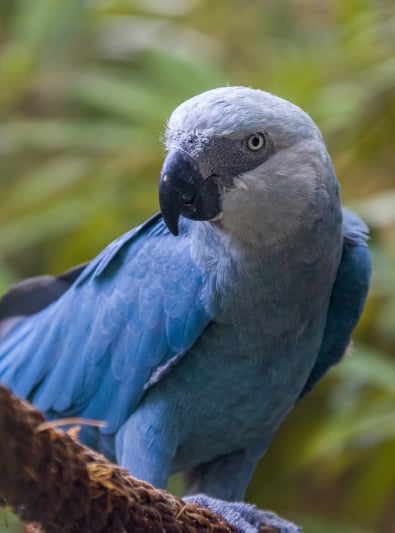Superb parrot with blue plumage, the Spix’s Macaw is today, almost non-existent in the wild.
However, a program to reintroduce birds born in captivity has recently been launched. Reputed to be fearful, this bird also possesses great skills in imitating sounds.
Scientific name: Cyanopsitta spixii

| Family | Psittacidae |
|---|---|
| Kind | Cyanopsitta |
| Weight | From 340 gr to 350 gr |
| spix macaw size | From 55 cm to 60 cm |
| how long do spix macaws live | 28 years |
|---|
Spix’s macaw habitat
The Spix Macaw is native to Brazil. He lived in the Amazon rainforest before his extinction.
History of the breed
The Spix’s Macaw was discovered by a Dutch settler in 17 th century, but it has been studied at the beginning of the following century by the German naturalist Johann Baptist von Spix Ritter.
The name was later given to this species in his honor. As for its description, it is attributed to the German zoologist Johann Georg Wagler, who would have done it in 1832.
At the time, Spix’s macaw numbers were already quite small, estimated at less than 200 individuals.
Spix’s macaw extinct
Poaching and the destruction of its natural habitat have made this animal even more rare.
Despite a law protecting the species that came into force in Brazil in 1967, individuals have continued to be captured.
No Spix Macaw could be observed in the wild until 1985, 5 birds having been seen then (5 including 2 pairs), but they also ended up being victims of poaching.
5 years later, Brazil set up the Standing Committee for the restoration of the Spix Macaw. Efforts have been made to encourage breeding in captivity, but problems with inbreeding have quickly emerged.
Today, the species is considered to be in extinction in the wild. A male was however seen in 2016. Captive birds, which number in the tens, live in the Canary Islands, Qatar and Germany, in addition to Brazil.
On March 3, 2020, 52 Macaws of Spix arrived in Brazil from Germany. They lived at the breeding and breeding center of the Association for the Conservation of Threatened Parrots (ACTP) in Berlin.
Their reintroduction into their natural environment is planned for 2021 in 2 vast reserves specially created by the Brazilian authorities.
Physical features
The Spix’s Macaw has entirely blue plumage, with greenish undertones on the abdomen. The head is light gray in color with bluish reflections. The bill is dark gray, even black.
The young have the striped beak in the center. Stripes that disappear at the age of one or 2 years. They also have light gray legs. The size of the tail increases as the bird grows.
When it comes to sex, the male is usually a bit taller than the female.

Behavior and character
The few Macaws of Spix observed in their natural environment evolved alone, in couples, or in a very small group. They are rather fearful; the slightest attempt to approach makes them flee.
Paul Roth, one of the rare people to have recently seen a Spix’s Macaw in the wild, saw a male accompanied by a female of a different species, in this case, Illiger’s Macaw. He used to escort him every night to his perch, before going back to his.
The Macaw of Spix would, moreover, have the capacity to imitate a variety of sounds.
Food
In the wild, the Spix’s Macaw consumes seeds and peanuts, favoring the Paranà pine nuts (tree in danger of extinction) and Cnidoscolus quercifolius.
Reproduction
In the Spix Macaw, the breeding period corresponds to the summer season. The nest is generally established in the hollow of a tree trunk.
In captivity, a female can lay up to 5 eggs.
Health
In captivity, the Spix’s Macaw suffers from disorders associated with inbreeding, such as infertility and death in utero.
There have also been cases of delayed sexual maturity.
Spix’s macaw population
SOURCE: ACTP e.V.
Read also:

